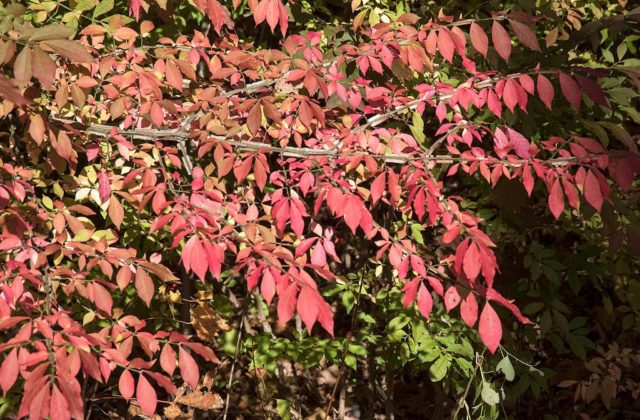Identifying Invasive Plants in Norfolk’s Village Center
Conservation Commission to lead inventory walk
By Martha Klein
Photo by Bruce Frisch
November is a perfect time of year to identify and remove invasive plants in Norfolk, because the fall color changes make some of these plants very visible. For example, the plant Burning Bush (Euonymus alatus) is an invasive shrub seen along roadsides near woods, and the leaves turn bright, burning-bush red at this time of year. The distinctive color and invasive properties that cause this plant to spread into Norfolk’s forest make this an easily identifiable native plant enemy, and one that should be removed in full everywhere that it is seen.
Another distinctive autumn plant is Oriental Bittersweet (Celastrus orbiculatus), which can be both a shrub and a climbing vine that attacks healthy native trees, and in some cases, contributes to both tree death and power line problems. This plant has bright yellow leaves in the fall, and large amounts of terminal orange berries, which are eaten and spread by birds. This plant is similar to the native plant American bittersweet (Celastrus scandens) but because of the rapid rate of growth, Oriental bittersweet outcompetes the native variety.
To protect Norfolk’s forests both now and in the future, it is necessary to manage these aggressive native plant killers, and the Conservation Commission is taking the lead. On Saturday, November 9 from 10 a.m. to noon, the Norfolk Conservation Commission will lead a walking invasive plant inventory of areas close to downtown, with a focus around City Meadow. We will meet in front of the Hub, 2 Station Place, at 10 a.m. There will be instruction on plant identification, and we will assess and take inventory of invasive plants around City Meadow, as well as along Station Place, John J. Curtis Road, Shepard Road, and parts of Route 44. Given adequate time, we will evaluate the path to Town Hall.
Please join us to learn about these and other invasive plants and find out what you can do to help.

